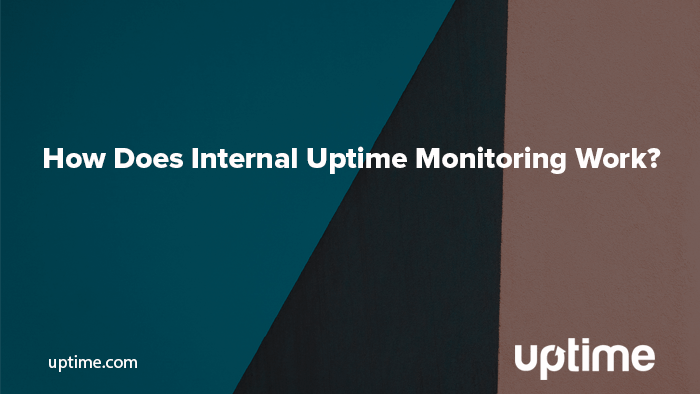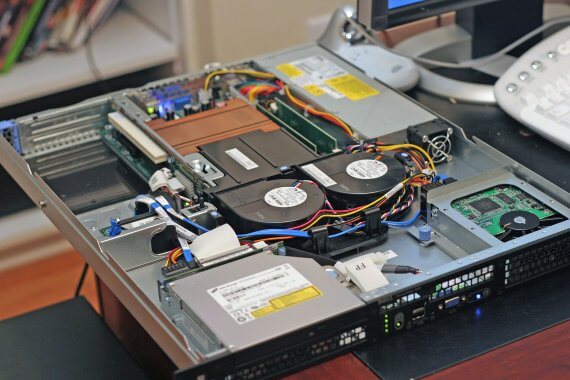
How Does Internal Uptime Monitoring Work?
Your site or application runs on a server, which is just another computer inside some server warehouse. That server is subject to the same kinds of limitations as your personal computer, and you need a way to determine usage of those resources similar to the internal monitoring for disk space or CPU usage that you find inside a Windows or Mac operating system.
These internal metrics collectively determine the power or capacity of your server. When you are hosting more complex sites or applications, you are essentially renting an allocation of these resources and must maintain an awareness of them at all times.

Server internals courtesy of Wikipedia
Looks pretty familiar, right?
Internal monitoring looks at these internal hardware metrics and measures their performance or state. Some monitoring tools just tell you if it’s up or down, others will go into more detailed data about how much of a resource has been consumed.
However you choose to approach internal monitoring, it’s important to consider how it will fit into your overall monitoring and observability plan so you can stay aware of problems as you scale.
What is Internal Uptime?
Internal uptime is a measure of how many resources an application consumes, how often its internal processes malfunction, and other key performance indicators that make up a system’s functionality.
Internal uptime monitoring is one of the first lines of defense a sysadmin has in detecting a downtime event.
What can Go Wrong?
Let’s look at some examples of issues that arise when internal systems have problems.
CPU Usage
Every task your application relies on is a series of instructions your server has to process. Send too many and your application can crash harder than the stunt team for a new Mad Max movie. Optimize your codebase and try to maximize performance, both for costs in server CPU and to improve the general user experience.
Bandwidth
When a user attempts to access your website, the collection of assets returned consumes bandwidth. Use your limited amount without allocating more and your public-facing infrastructure will typically go down.
Disk Space
Disk space is critical to growing operations, especially those utilizing CRM software or applying updates. As your database grows, a lack of disk space can cause outages or slow performance.
How Internal Uptime Monitoring Works
An internal monitoring system sits behind a Web Application Firewall (WAF) or load balancer. This type of monitor is often an installable agent or a private probe server that must be installed within your system, and usually, (but not always) will securely communicate metrics to some third-party source. If you configure integrations, you may be sharing data between services.
The word “internal” suggests it is organization-dependent meaning needs may change based on who is doing the monitoring. Because internal monitoring can encompass a multitude of processes, it is important to begin the discussion by first defining what your organization wants to track.
Private Location Monitoring
Private location monitoring is similar to an external monitoring system, but is designed to live within your system. Private location monitoring offers access to many of the same toolsets as Uptime.com checks, such as HTTP(S) or Ping checks, with the advantage of reporting and status pages.
A private location probe server is most useful when monitoring intranet applications, or systems connected with your internal infrastructure. Its job is to tell administrators when an aspect of your internal infrastructure goes down, and provide first alert and first response capabilities to the outage. One example is a probe monitoring your API from within, which can queue you into performance issues that may signal an imminent outage.
Installable Agents
An installable agent is installed within your infrastructure, but in contrast to the private location its job is to monitor server resources. Rather than reporting on the state of an application, it will inform sysadmins of resource usage and general state of the system.
Installable agents are most useful in helping you understand how your internal infrastructure performing. The data you gather can help inform your current and future development efforts, as well as resource allocations as you grow. You can save costs, and potentially preempt major outages when you have more data on what your system is doing.
Internal Monitoring Benefits
Internal monitoring is like a medical physical. It tells you what your system is doing, how it’s performing, and generally gives a picture of health so you can make some informed decisions. If you are struggling with performance, internal monitoring may be able to help pinpoint issues so you can diagnose and fix the problem.
Internal Monitoring Shortcomings
Internal is limited to inside your system. Internal monitoring can only see within those confines, and is also subject to its outages. It is not designed to notice if a page your customers need to see fails, nor will it track page performance.
If the system governing your internal monitoring fails, your internal monitoring will follow suit. If you only rely on internal monitoring, you will lose all visibility in this scenario.
Monitoring Your System Effectively
Internal monitoring is built on good alerting. If you’re not aware of the problem, it doesn’t matter that you’re tracking it.
If you’re looking for internal monitoring, we recommend you also look at data retention and alerting options. What integrations are maintained by the service? How many options do you have to alert the right user at the right time? Can you account for maintenance or scheduled outages?
Fortunately, Uptime.com does it all: internal private location monitoring, external synthetic monitoring, robust SLA reporting, and private status pages as well as internal dashboards. From startups to enterprise, building good monitoring into your infrastructure will only improve your observability over time.
Minute-by-minute Uptime checks.
Start your 14-day free trial with no credit card required at Uptime.com.
 Uptime.com Blog
Uptime.com Blog


